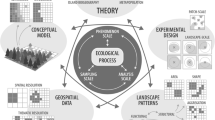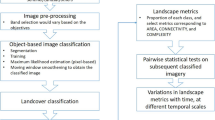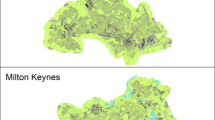Abstract
Discerning the function of a landscape involves comparing landscape use with spatial patterns. To do this requires both quantification of landscape use and landscape pattern and a means of comparing the two. An index of lacunarity has been used to quantify spatial pattern (specifically, habitat contagion). We demonstrate a new way of using the lacunarity index to quantify landscape function as well. We calculated lacunarity to describe landscape patchiness of experimental landscapes with respect to patterns of habitat and non-habitat areas (the previous use of lacunarity) as well as to describe patterns of patch use by animals in those landscapes, irrespective of habitat-patch patterns (a novel application of lacunarity). We demonstrate a disparity between landscape pattern and landscape use. This finding suggests that drawing generalizations of, and making predictions about, how animals respond to landscape spatial structure may not be straightforward.
Similar content being viewed by others
References
Allain, C. and Cloitre, M. 1991. Characterizing the lacunarity of random and deterministic fractal sets. Phys Rev A44: 3552–3558.
Bain M. B. and Robinson, C. L. 1988. Structure, performance, and assumptions of riverine habitat suitability index models. Aquatic Resource Res Series 88-3,Alabama Cooperative Fish and Wildlife Research Unit, Auburn University, Auburn, AL.
Calkins, C. O. and Kirk, V. M. 1973. Distribution and movement of adult false wireworms in a wheat field. Ann Entomol Soc America 66: 527–532.
Cody, R. P. and Smith, J. K. 1991. Applied Statistics and the SAS® Programming Language, third edition. Prentice Hall, Englewood Cliffs, NJ.
Crist, T. O., Guertin, D. S., Wiens, J. A. and Milne, B. T. 1992. Animal movements in heterogeneous landscapes: An experiment with Eleodes beetles in short grass prairie. Funct Ecol 6: 536–544.
Crist, T. O. and Wiens, J. A. 1995. Individual movements and estimation of population size in darkling beetles (Coleoptera: Tenebrionidae). J Animal Ecol 64: 723–746.
Doyen, J. T. and Tschinkel, W. F. 1974. Population size, microgeographic distribution, and habitat separation in some tenebrionid beetles. Ann Entomol Soc America 67: 617–626.
Ebert, T. A. 1990. Interactions between pesticide applications and food resources in a Pasimachus elongatus population. M.S. Thesis, Colorado State University, Fort Collins, CO.
Fahrig, L. and Merriam, G. 1994. Conservation of fragmented populations. Cons Biol 8: 50–59.
Henebry, G. M. and Kux, H. J. H. 1995. Lacunarity as a texture measure for SAR imagery. Int J Remote Sensing 16: 565–571.
Hobbs, R. 1997. Future landscapes and the future of landscape ecology. Landscape Urban Planning 37: 1–9.
Johnson, A. R., Milne, B. T. and Wiens, J.A. 1992. Diffusion in fractal landscapes: Simulations and experimental studies of tenebrionid beetle movements. Ecology 73: 1968–1983.
Lin, B. and Yang Z. R. 1986. A suggested lacunarity expression for Sierpinski carpets. J Phys A19: L49–L52.
Mandelbrot, B. B. 1983. The Fractal Geometry of Nature. W.H. Freeman, New York, NY.
McClean, S. A., Rumble, M. A., King, R. M. and Baker, W. L. 1998. Evaluation of resource selection methods with different definitions of availability. J Wildlife Manage 62: 793–801.
McIntyre, N. E. 1997. Scale-dependent habitat selection by the darkling beetle Eleodes hispilabris (Coleoptera: Tenebrionidae). Am Midland Nat 138: 230–235.
McIntyre, N. E. and Wiens, J. A. In press. How does habitat patch size affect animal movement?: An experiment with darkling beetles. Ecology.
Mladenoff, D. J. and Sickley, T. A. 1998. Assessing potential gray wolf restoration in the northeastern United States: A spatial prediction of favorable habitat and potential populations levels. J Wildlife Manage 62: 1–10.
Plotnick, R. E., Gardner, R. H., Hargrove, W. W., Prestegaard, K. and Perlmutter, M. 1996. Lacunarity analysis: A general technique for the analysis of spatial patterns. Phys Rev E 53(5B): 5461–5468.
Plotnick, R. E., Gardner, R. H. and O'Neill, R. V. 1993. Lacunarity indices as measures of landscape texture. Landscape Ecol 8: 201–211.
Riitters, K. H., O'Neill, R. V., Wickham, J. D. and Jones, K. B. 1996. A note on contagion indices for landscape analysis. Landscape Ecol 11: 197–202.
Rogers, L. E., Woodley, N. E, Sheldon, J. K and Beedlow, P. A. 1988. Diets of darkling beetles (Coleoptera: Tenebrionidae) within a shrub-steppe ecosystem. Annals of the Entomol Soc America 81: 782–791.
SAS Institute Inc. 1988. SAS/STAT® User's Guide, Release 6.03. SAS Institute Inc., Cary, NC.
Schroeder, R. 1986. Habitat suitability index models: Wildlife species richness in shelterbelts. U.S. Fish and Wildlife Service FWS/OBS-82/10.28, 17 pp.
Short, H. L. 1984. Habitat suitability index models: The Arizona guild and layers of habitat model. U.S. Fish and Wildlife Service FWS/OBS-82/10.70., 37 pp.
Turner, M. G. 1989. Landscape ecology: The effect of pattern on process. Annual Review of Ecol Syst 20: 171–197.
Van Horne, B. and Wiens J. A. 1991. Forest bird habitat suitability models and the development of general habitat models. U.S. Fish and Wildlife Service Fish and Wildlife Research 8, 31 pp.
Whicker, A. D. 1983. Spatial and temporal distributions of tenebrionid beetles, genus Eleodes, in a grassland community. Ph.D. Dissertation, Colorado State University, Fort Collins, CO.
Whicker, A. D. and Tracy, C. R. 1987. Tenebrionid beetles in the shortgrass prairie: Daily and seasonal patterns of activity and temperature. Ecol Ent 12: 97–108.
Wiens, J. A. 1992. What is landscape ecology, really? Landscape Ecol 7: 149–150.
Wiens, J. A. 1996. Wildlife in patchy environments: Metapopulations, mosaics, and management. pp. 53–84 In Metapopulations and Wildlife Conservation. pp. 53–84. Edited by D. R. McCullough. Island Press, Washington, D.C.
Wiens, J. A., and Milne, B. T. 1989. Scaling of ‘landscapes’ in landscape ecology, or, landscape ecology from a beetle's perspective. Landscape Ecol 3: 87–96.
Wiens, J. A., Crist, T. O. and Milne, B. R. 1993. On quantifying insect movements. Env Entomol 22: 709–715.
Wiens, J. A., Schooley, R. L. and Weeks, R. D. 1997. Patchy landscapes and animal movements: Do beetles percolate? Oikos 78: 257–264.
With, K. A. and Crist, T. O. 1995. Critical thresholds in species' responses to landscape structure. Ecology 76: 2446–2459.
With, K. A. and King, A.W. 1997. The use and misuse of neutral landscape models in ecology. Oikos 79: 219–229.
Yount, V. A. 1971. Diets of selected insects in a grassland ecosystem. M.S. Thesis, Colorado State University, Fort Collins, CO.
Author information
Authors and Affiliations
Rights and permissions
About this article
Cite this article
McIntyre, N.E., Wiens, J.A. A novel use of the lacunarity index to discern landscape function. Landscape Ecology 15, 313–321 (2000). https://doi.org/10.1023/A:1008148514268
Issue Date:
DOI: https://doi.org/10.1023/A:1008148514268




